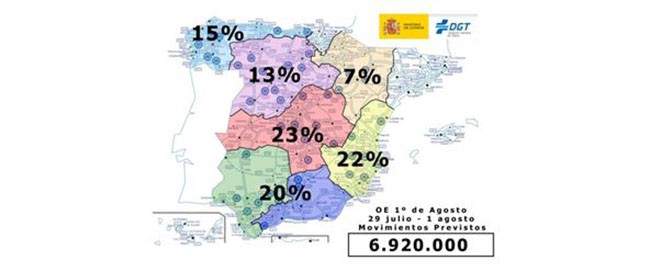From 3:00 p.m. tomorrow, Friday, July 29, until 12:00 a.m. on Monday, August 1, the DGT will be operating a special traffic management and surveillance device to monitor the 6.9 million trips planned by road.

As it coincides on Monday, August 1, it is expected that many Spaniards will start their holidays on Friday, July 29, which will translate, for traffic purposes, into a high number of trips and a high flow of traffic.
In addition to long-distance journeys, these three days also coincide with weekend journeys, those that end their vacations and the vehicles that cross the peninsula to the Maghreb countries within the framework of Operation Passage of the Strait. All this will mean days of high circulatory activity.
Despite the fact that August 1st is still the start date of vacations for thousands of citizens, the trend in recent years has been to fragment them and enjoy them in shorter periods. For this reason and throughout the summer, the General Directorate of Traffic will continue to implement special traffic regulation and surveillance devices during all summer weekends, in order to meet the needs of drivers.
The roads that will have a higher intensity of traffic during this operation will be:

Measures to make movements fluid
To facilitate road mobility, the DGT will establish the following measures:
Installation of reversible and additional lanes with cones at times of greatest traffic flow and in sections of certain roads.
Stoppage of works on specific roads to minimise the effect on traffic during the days of the summer departure-return operation.
Restriction of the movement of dangerous goods vehicles and special transport in areas of special intensity.
Design of alternative itineraries, in order to optimise travel times and safety.
The holding of sporting events and other events will be limited.
Dynamic signalling through 2,200 variable message panels of the main traffic variables: travel times, alternative routes, incidents on the road, etc.
Timely information on any incident on the road through the newsletters of the radio stations, on social networks with the hashtags #VeranoSeguro and #SaberloEsEmpezarAEvitarlo, on the internet and on the 011 telephone.
…And above all safe
The important thing is to arrive at the place of destination and enjoy the holidays, for this reason, the DGT verifies through the following means that the behaviour of drivers on the road is in accordance with traffic and road safety regulations:
- To check that speed limits are being followed:
– 780 fixed speed control radars, of which 92 are sectional.
– 545 mobile radars that can be installed on Guardia Civil vehicles.
– 12 helicopters that are equipped with the Pegasus speed measurement system.
- For Seat Belt Usage and Distraction Monitoring (Mobile):
– 245 cameras installed.
– 15 vans.
– 12 helicopters.
– 23 of the 39 drones available to the DGT have the capacity to report.
- To monitor these and other behaviours, in addition to the means mentioned above, the DGT has unmarked vehicles and motorcycles that will circulate on all types of roads.
- To remove from circulation people who have ingested alcohol or other drugs and drive, preventive controls will be intensified at any time of the day and on any road. In addition, in the week of August 8, a special surveillance and awareness campaign will be carried out on this risk factor in driving. According to the 2021 Memory of Toxicological Findings in Traffic Accident Victims, the presence of psychotropic substances was detected in half of the deceased drivers
To carry out the entire device, the DGT has the Traffic Group of the Guardia Civil, officials from the 7 traffic management centres, specialised technical personnel, employees of maintenance companies and emergency services personnel; all of them will be working during these days so that drivers can make a safe trip.
According to Pere Navarro: “We have everything ready so that the planned millions of trips are carried out smoothly and safely, but we need the responsibility of each and every one of the road users to be able to achieve this. On the road, there are no excuses, because after an accident, nothing is ever the same again”.
Simple gestures that avoid accidents
- Better slower, especially on conventional roads, where the generic speed is 90km/h.
- Respect the speed limits established on each road and maintain a safe distance from the preceding vehicle. Invading this safety distance is aggressive, unacceptable and, most seriously, it causes accidents.
- If you drink do not drive and if someone in the group you are with has been drinking, it is your responsibility not to let them drive.
- Turn off the mobile if you are going to drive or put the car mode on those devices that have it incorporated. There is nothing that cannot wait. Also, if you go as a passenger, do not let the driver manipulate the mobile.
- Wear your seat belt properly and keep minors in their child restraint system, both on long and short journeys.
- Stop every two hours on long journeys to rest. Driving fatigue is a bad ally.
- Special attention to motorcyclists and other drivers due to the vulnerability of two wheels.
- If you are a bicycle user, in addition to the helmet, you must ride with lights and reflective clothing at night or in low visibility conditions. Drivers must exercise extreme caution and not perform any manoeuvre that endangers cyclists. Vehicles that need to overtake a bicycle will have to do so completely occupying the adjoining lane if the road has 2 or more lanes in each direction. And if the road only has one lane, keep the minimum separation of 1.5 metres.
- In the case of pedestrians, if you walk on roads outside the town, remember that you must do so on the left and if it is at night or in weather or environmental conditions that significantly reduce visibility, you must wear a high visibility vest or other reflective clothing.




